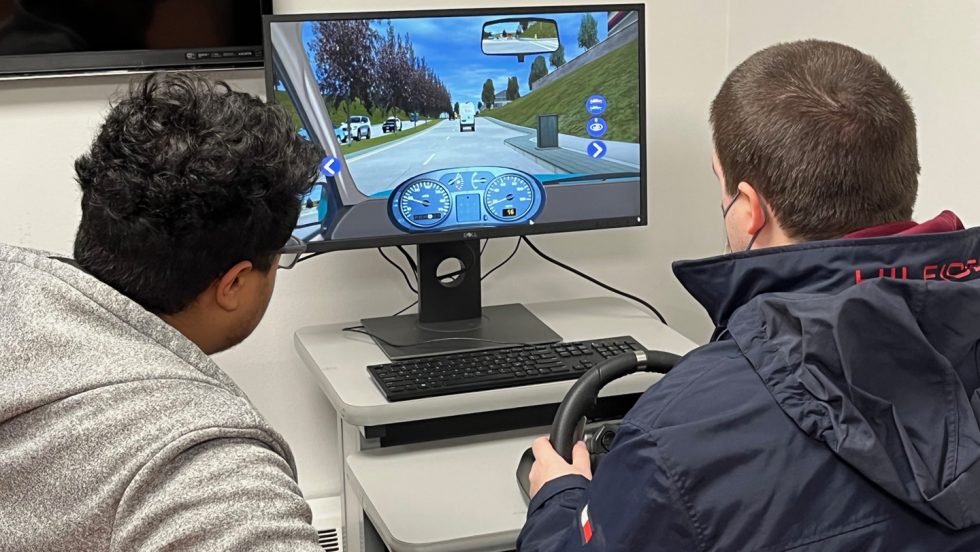
The Bridges to Adelphi program and Gersh Drivers Ed are partnering to help college students on the autism spectrum get their licenses.
There’s a fair amount of traffic in the city on a recent Saturday morning, though clear skies make the driving easier for students. However, the students are not behind the wheel of an actual car. Instead, these are simulated road conditions that are part of a new driving school in the Bridges to Adelphi program. In collaboration with Gersh Drivers Ed in Huntington, an affiliated program of the Gersh Academy, it’s the first college program on Long Island designed to meet the learning style of neurodivergent students. It gives students, many of whom are on the autism spectrum, the opportunity to learn the logistics and basics of driving without the high-pressure, often anxiety-producing situation of being in a car, according to Gersh instructor Christian Gustave—and to obtain a driver’s permit and then a license.
Diana Damilatis-Kull ’10, MA ’12, MA ’14, director of the Bridges to Adelphi program and an adjunct faculty member in the Gordon F. Derner School of Psychology, said many individuals on the spectrum receive their license much later in life or not at all, causing them to be dependent on others to drive them to class and appointments and to their jobs. “When you get your license, you’re able to go and come as you please, so it’s a big milestone for many people, including our students, and the next bridge into the real world.”
Marken Suaza, 22, a senior anthropology major who is graduating in December, currently commutes from Valley Stream, New York, by public transportation or with help from his family. “Since I’m going to be done with school and working, it would be helpful to be able to drive myself places and have independence,” he said. “I got my permit during the pandemic and took my road test last year and I was doing pretty good until parallel parking. I thought I should I try [this program], get some good practice and make sure to get my license this time.”
A Drivers License in Four Phases
The program consists of four phases over 48 weeks. The first, which prepares students to take the permit test, began on September 19. The second phase, which began on September 25, uses a virtual driving simulator in the Bridges office. Gustave said he can change the level of traffic, the landscape, time of day, visibility and weather conditions, and the focus is on the mechanics of using a car. In the spring, students can move on to the third phase, which will utilize golf carts on campus and will be supported by the Department of Public Safety and Transportation. In the final phase, students get instruction in an actual car, first on campus and then in the surrounding neighborhood. Currently, five Adelphi students are in the permit phase and six are in the simulation phase.
Gustave said the way the program is structured “is a progression that gets them comfortable, allowing them to learn first the basics. Also, I think a lot of the students are familiar with each other, having been in the Bridges program, so it gives them a familiar setting in which to learn the principles of driving.”
That comfort level is a key factor for Damilatis-Kull. “I think the benefit of this opportunity is we’re housing it here, so there’s not an additional obstacle for students on the spectrum of going to a place they’re not comfortable with,” she said.
This has become an important component in getting his license for Nicolas Rontanini, 22, a senior communications major who currently commutes to Adelphi from Williston Park on Long Island either by Uber or with a family member. Rontanini, who is in phase two, said though he recently got his permit, he didn’t take drivers ed in high school because he could walk to school.
Rontanini plans to continue in the program after he graduates in December. “It helps to have access to a program that I’ve been in for so long and to be able to be in a comfortable environment. When you’re doing something for the first time, you could easily be discouraged.”
Tailored to Students on the Spectrum
Joel B. Geller, executive director of the Gersh Drivers Ed program, said it’s open to all abilities. He explained that unlike neurotypical drivers ed classes, which are limited to 36 students in a classroom, this program for neurodivergent students is designed to have class sizes no larger than 12. Generally, class sizes are between four and eight students.
“The traditional neurotypical classes would be sensory overload,” he said. “These classes are an easy, smooth transition from phase to phase and each reinforces the phase before. We take our time and break things down so it’s a lot easier for them to understand. It is our goal to provide each student with the necessary information and techniques needed to be a safe and responsible driver and to provide a learning-friendly environment that meets the needs of each student’s learning style. My core value is they don’t learn the way we teach; we teach the way they learn.”